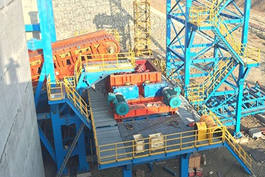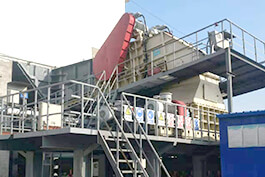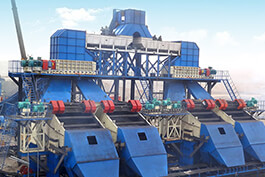Introduction
The Mineral sizer adopts a double-toothed roller design. Through the rotation of the toothed rollers, it shears, stretches and grinds materials, making it suitable for medium and fine crushing of various materials. It has a particularly good crushing effect on materials with high moisture content and high viscosity. Moreover, the Mineral sizer can flexibly control the output particle size by adjusting the gap between the toothed rollers. It generates less dust during the crushing process, which is beneficial for environmental protection. Its modular design makes it highly efficient in crushing and suitable for large-scale mines or projects with high continuous production demands.
The jaw crusher crushes materials by repeatedly squeezing them between the movable jaw and the fixed jaw. It is suitable for the primary crushing of large-sized, hard and low-moisture content ores. With a relatively simple structure, it is easy to maintain and suitable for small and medium-sized open-pit mines or projects with fluctuating production rhythms.
Differences in Operating Principles
Mineral sizer
The operating principle of the mineral sizer mainly relies on the organic combination of shearing, stretching, and grinding. As the toothed rollers rotate, the teeth cut the material, and the mutual compression and friction between materials also aid in the crushing process. This integrated operation mode allows the mineral sizer to effectively avoid clogging caused by material adhesion when processing highly viscous materials. Furthermore, since the rotation of the toothed rollers and the interaction between materials allow precise control over the force and direction of the crushing process, the mineral sizer can more effectively adjust and control the final product's particle size distribution, ensuring that the output material meets the desired particle size requirements.
Jaw crusher
The jaw crusher's working components are two jaw plates: a fixed jaw plate (fixed jaw) and a movable jaw plate (moving jaw). The fixed jaw plate is mounted vertically (or slightly outward at the top) on the front wall of the machine body, while the movable jaw plate is inclined, forming a crushing chamber that is larger at the top and smaller at the bottom. The movable jaw plate moves in a periodic reciprocating motion, occasionally separating from and then coming close to the fixed jaw plate. When separated, the material enters the crushing chamber, and the finished product is discharged from the bottom. When the plates come together, the material between them is crushed through compression, bending, and splitting.
Differences in Components
Mineral Sizer Components
The mineral sizer is mainly composed of the motor, hydraulic coupling, gearbox, self-aligning drum-shaped gear coupling, and toothed rollers, with a modular design.
Motor: In the mineral sizer, two toothed rollers are driven by two independent motors, each rotating a toothed roller, providing power for the crushing operation and ensuring stability and efficiency during the crushing process.
Hydraulic Coupling: The hydraulic coupling, as a power transmission device, can absorb and buffer the impact loads during the motor startup, protecting the motor that provides power to the mineral sizer from damage, while improving the stability of power transmission and ensuring the stability of the crushing process of the equipment.
Gearbox: The gearbox reduces the motor's speed and increases torque to meet the power demands for the mineral sizer's toothed roller material crushing. The gearbox design ensures that the toothed rollers run at an appropriate speed, optimizing both crushing efficiency and energy consumption.
Self-aligning Drum-shaped Gear Coupling: The self-aligning drum-shaped gear coupling, as an important component connecting the reducer and the toothed roller, has the ability to automatically adjust the axis deviation, ensuring the stability and reliability of the toothed roller of the mineral sizer during rotation, reducing the vibration and noise caused by misalignment of the axis, and maintaining the stability of the mineral sizer's crushing operation.
Toothed Rollers: The core components of the mineral sizer, made of high-strength wear-resistant materials, are specially treated to enhance their wear and corrosion resistance. The design of the toothed rollers considers material properties and crushing needs to ensure that the crushing process meets the required particle size and maintains long-term stable operation of the equipment.
.jpg)
Jaw Crusher Components
The jaw crusher consists of the fixed body, rotating body, safety device, and adjustment device.
Fixed Body: The main part of the fixed body is the frame, which can be either a medium carbon steel cast frame or a welded steel plate frame. The welded frame includes additional reinforcement ribs to achieve similar performance to a cast frame through strict quality control and specific process requirements. Wear plates are installed on the left and right sides of the crushing chamber to prevent severe wear and can be replaced.
Rotating Body: Composed of the moving jaw, eccentric shaft, bearings, and pulley, this part is responsible for the transmission and force-bearing of the jaw crusher.
Adjustment Device: This device adjusts the size of the discharge opening to control the output particle size. The jaw crusher's adjustment mechanism has two forms: wedge block type and toggle plate type, both of which are convenient and flexible, allowing for stepless adjustment.
Differences in Design Structure
Frame Structure
Mineral Sizer: The frame design of the mineral sizer fully considers the high load and vibration factors during the crushing operation, using thick steel plates welded together to ensure sufficient rigidity and strength. The box-shaped frame structure not only improves the equipment's stability but also provides good protection for internal components, extending the equipment's service life. This frame design is also convenient for installation and adjustment, allowing the mineral sizer to adapt to different crushing needs and material characteristics.
Jaw Crusher: The jaw crusher's frame comes in two types: welded and assembled. The welded structure is simple and low-cost but may experience welding deformation. The assembled frame is stronger, avoids stress concentration caused by welding, and is more durable, making it suitable for large-scale products, although it is more expensive.
Crushing Chamber Type
Mineral Sizer: The crushing chamber of the Mineral sizer is a closed space formed by welded steel plates. This welded structure usually has high strength and sealing performance, and can withstand the impact and compression of materials during the crushing process. After the materials enter the chamber, they will be forcibly compressed and sheared under the rotation of the toothed rollers. The walls of the chamber constrain the movement trajectory of the materials and restrict their movement in irrelevant directions, ensuring that the crushing energy is concentrated on the materials. During the crushing process of the Mineral sizer, the materials may generate fragments and fly around. The closed chamber can prevent these fragments from flying out of the equipment, thus protecting the safety of the operators and the cleanliness of the surrounding environment.
Jaw Crusher: Traditional crushing chambers are "right-angled triangular," while the new design uses an "isosceles triangle" shape. The new design accommodates larger feed sizes, improving feeding capacity and yield. The new jaw crushers typically have an angle of 18°-21°, while the traditional ones are between 21°-24°. A smaller angle results in greater crushing force and larger processing capacity.
Motor Installation
Mineral Sizer: Two motors are jointly installed on the motor bracket, which serves as the core load-bearing structure and is typically fabricated by welding high-strength steel to ensure sufficient rigidity and load-bearing capacity. As the power source for the mineral sizer, the installation of the two motors must strictly guarantee their coaxiality with the transmission system (such as reducers, couplings, etc.). The motor bracket is pre-provided with precise installation holes, locating pins or adjustment shims, and the motors are firmly fixed to the bracket with bolts. At the same time, it allows for minor adjustments to the motor positions during installation to ensure that the output shafts of the two motors are aligned with the axes of the subsequent transmission components.
Jaw Crusher: There are two ways to install the motor: the motor can either be placed directly on the crusher's frame (integrated) or mounted independently on the foundation. Integrated installation saves space and reduces foundation vibration, but it requires a reliable motor. Independent installation increases foundation vibration and has stricter foundation requirements.
Lubrication System
Mineral Sizer: The mineral sizer is equipped with a centralized lubrication system, ensuring that all lubrication points receive adequate and uniform lubrication during operation. This helps reduce mechanical wear, extend the life of the mineral sizer, and improve overall work efficiency. The centralized system also makes lubrication operations more convenient and efficient, reducing the frequency and difficulty of manual maintenance, further enhancing the reliability and stability of the equipment.
Jaw Crusher: Conventional jaw crushers usually rely on manual lubrication during operation. This method involves adding lubricating oil or grease to the lubrication points regularly to ensure smooth operation of the moving parts, reducing wear and extending service life.
Conclusion
The choice between the two depends on the specific working conditions. If you are dealing with materials that have high viscosity and moisture content or need fine, uniform particles in large-scale continuous operations, the mineral sizer is the better choice. However, for primary crushing of large, hard ores in smaller or more variable production scenarios, the traditional jaw crusher remains a practical and economical option.


.jpg)
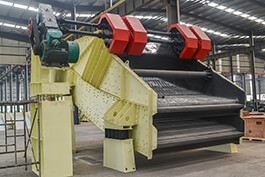

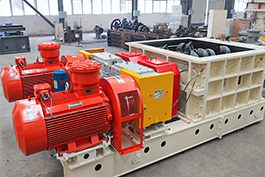
.jpg)
